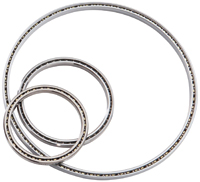
Posted to News on 27th Jan 2020, 00:00
Why thin section bearings should be on every design engineer"s radar
Carter Manufacturing’s Mike Page explains why thin section bearings should be on every design engineer’s radar where space is tight, weight saving is required and where tolerances are extreme.

Thin section bearings offer design engineers a unique combination of advantages in a single, hard wearing and lightweight package. As the name implies, they are significantly thinner in section than ‘ordinary’ rotating bearings and possess attributes that make them very different from ordinary radial bearings. One of the most important (and useful) of these is that whereas most radial bearings are designed so that the bearing thickness increases proportionately as the bore size gets bigger, in the case of thin-section bearings, the thickness remains fixed even though the bore size increases.
Generally, thin-section bearings are specified for use in critical applications and environments where space is tight, weight must be minimised and absolute precision. In these types of application, thin section bearings have helped to reduce the total cost in a system by allowing for design efficiency over standard bearing sizes, with the added advantage of using just a single bearing which shows little change in its weight even as its diameter increases.
Speaking of weight saving, the advantages offered by thin-section bearings in this respect can be substantial. For example, on a bearing with a bore of 100mm, a thin-section bearing might weigh 1kg less than a standard option. And on a larger bearing with a bore of around 900mm the weight saving could be in the region of 400kg. Serious numbers. However, when designing with thin-section bearings, engineers should always remain aware that they can be affected by the tolerance, roundness, and expansion and contraction rates of the housing and shafts used to mount them. The range of temperatures in which thin-section bearings will typically operate is –52°C to +120°C.
Thin section bearings can be manufactured in a variety of materials, with 52100 vacuum-gassed chrome steel and 440C martensitic stainless steel being amongst the most popularly specified, although 17-4PH and M50 tool steel can also be specified. As with many other types of bearing, thin-section bearings can also be specified with a variety of specialist coatings if required. Examples include thin-dense chrome which helps to extend service life, delivers even smoother running and assists in combating corrosion.
Designers can choose between three definitive types of thin-section bearing, dependent upon their application requirements, with each of them delivering a different set of advantages. Radial contact by the balls may be preferred for some uses, whereas the alternatives of either angular or four-point contact might be preferred for others. Likewise, designers can make choices regarding ball types (including ceramic balls) together with different cage designs, alternative materials options and a variety of lubrication choices. On some thin-section bearings, special seals and/or retainers can be manufactured too.
The combination of thin-section size preferences, the various materials choices, finishing processes and roller-contact types and materials are all vital elements in early discussions on the sort of projects in which these bearings excel.
As with all bearings, lubrication is an essential element that should be considered in advance, and OEMs invariably choose one of the three lubricant types which are most commonly used: oil, grease, and dry film or surface treatment. Oil normally provides better lubrication because it covers critical surfaces more thoroughly and dissipates heat more rapidly, whereas grease is clearly more easily retained, allowing the use of simplified bearing housings and seals.
It should be noted that in addition to ‘standard’ lubricating oils and greases, leading thin-section bearing manufacturers can also offer vacuum-compatible oils and greases, as well as dry film lubricants alluded to previously, including graphite, tungsten disulphide, silver, lead, PTFE and molybdenum disulphide to assure lengthy and trouble-free thin-section bearing service life.
Unwanted moment loads can be the design engineer’s enemy, and in the combating of unwanted axial or radial loads, thin-section bearings have been proven to excel, partly because they are designed from the outset to cope with it. Project designs which are expected to generate significant moment loads but which also have critical space and weight-saving requirements (to say nothing of the need for cost-reduction) often see the maximum benefit from the use of a single, thin-section bearing rather than paired standard bearings. This is because the thin-section design delivers inherent resistance to moment load, so the lifespan of a critical bearing can be greatly enhanced if a thin-section type is deemed suitable.
Ruland Manufacturing thin section bearings are available in the UK from Acorn Industrial.
Unit A, Denby Way
Hellaby Industrial Estate
S66 8HR
UNITED KINGDOM
+44 (01709 789949








